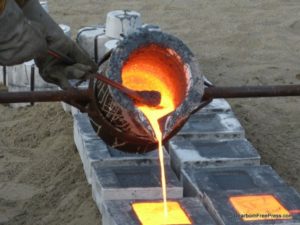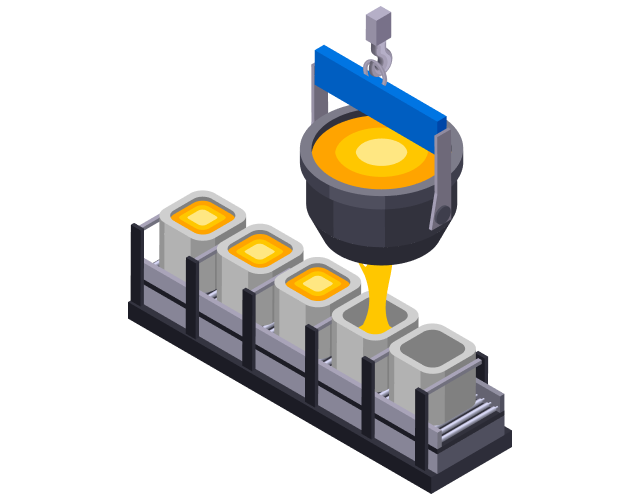Recognizing the Steel Castings Process: A Comprehensive Overview for Beginners
The Metal Casting procedure is an essential method in producing that transforms molten steel right into strong types. Beginners must grasp the different approaches involved, such as sand casting and pass away spreading. Recognizing the materials, style concepts, and precaution is equally essential. Each facet plays an essential duty in achieving effective results. As one navigates these ins and outs, the concern of just how to optimize each action for improved outcomes becomes progressively relevant.
The Essentials of Metal Casting
Metal Casting has progressed over centuries, its basic concepts continue to be essential and regular to the manufacturing procedure. At its core, Metal Casting entails the change of liquified steel into solid things with various methods. The procedure begins with the development of a mold, which defines the shape of the end product. When the mold and mildew is prepared, metal is heated up to its melting factor and poured right into the dental caries. After cooling, the steel solidifies, taking the form of the mold.
There are a number of casting approaches, including sand spreading, investment casting, and die spreading, each with one-of-a-kind advantages and applications. The choice of technique depends on variables such as manufacturing quantity, material type, and desired accuracy. Once cast, the last product might undergo additional processes like machining or surface therapy to accomplish the called for finish and specs. Understanding these fundamentals is crucial for any person interested in the area of Metal Casting.

Comprehending Products Used in Steel Casting
Products play an important duty in the Metal Casting procedure, influencing the end product's properties and efficiency. Different steels are used, consisting of light weight aluminum, steel, iron, and bronze, each offering distinctive features fit for details applications. Light weight aluminum is corrosion-resistant and lightweight, making it perfect for automotive components. Iron, specifically cast iron, is favored for its exceptional wear resistance and sturdiness. Steel supplies high toughness and convenience, commonly made use of in hefty machinery elements. Bronze, understood for its deterioration resistance and machinability, is frequently used in marine applications.
Along with the steels, numerous casting products, such as sand, plaster, and ceramic, are utilized to produce molds. Sand spreading, one of the most common technique, uses silica sand as a result of its thermal security and capability to develop detailed forms. Plaster and ceramic mold and mildews supply better details yet may need more intricate procedures. The option of products straight influences the effectiveness, price, and high quality of the spreading operation.
The Style Refine: From Concept to Blueprint
The design process in Metal Casting begins with the first concept growth, where ideas are generated and reviewed. This is complied with by the application of CAD modeling strategies, permitting specific visualizations of the style. Finally, the blueprint completion steps ensure that all specs are precisely recorded for manufacturing.
Initial Idea Development
Preliminary idea advancement marks an important phase in the Metal Casting procedure, where ideas change right into substantial layouts. Throughout this phase, designers team up with designers and stakeholders to brainstorm and refine first ideas. They consider aspects such as functionality, aesthetic appeals, and manufacturability, guaranteeing that the design meets the called for requirements and performance standards. Illustrations and outlines are created to picture the ideas, permitting preliminary assessments of usefulness and cost-effectiveness. This stage additionally involves recognizing materials and prospective spreading approaches that line up with the design goals. Eventually, first idea growth lays the foundation for an extensive plan, leading the succeeding stages of the casting procedure and making certain a successful change from principle to reality.
CAD Modeling Techniques
Transforming concepts right into specific layouts, CAD modeling techniques play a crucial function in the Metal Casting process. These techniques use advanced software to develop detailed three-dimensional models that accurately show the intended product. By utilizing tools such as parametric modeling, strong modeling, and surface modeling, developers can control measurements and shapes easily. CAD systems additionally promote simulation and evaluation, enabling the identification of potential problems prior to manufacturing begins. This proactive strategy lowers material waste and optimizes the layout for manufacturability. In addition, CAD models can be conveniently modified, enabling quick models based on feedback. Fundamentally, CAD modeling acts as the backbone of the design process, linking the space between preliminary principles and the eventual production-ready styles.
Blueprint Finalization Steps
Adhering to the creation of in-depth CAD models, the following stage includes plan completion, which is crucial in converting electronic layouts into workable plans for production. This process begins with reviewing the CAD designs for precision and conformity with specifications. Once verified, the dimensions, resistances, and material requirements are carefully detailed to ensure quality. Integrating notes and annotations helps communicate essential information relating to casting procedures, surface coatings, and assembly requirements. The completed blueprint goes through a strenuous approval process, frequently including collaboration with designers and manufacturing teams to attend to any potential issues. Nevertheless revisions are made and approvals gotten, the plan is formally launched, functioning as the fundamental document for the succeeding stages of Metal Casting, including pattern production and mold and mildew design.
The Steel Casting Strategies Described

Metal Casting methods include a range of techniques utilized to form molten steel into wanted types. These strategies differ according to the kind of material, intricacy of the style, and production quantity. Sand casting is among one of the most typical techniques, involving the production of a mold and mildew from sand to hold the liquified metal. Investment casting, or lost-wax casting, permits for detailed designs by utilizing a wax pattern that is thawed away. Pass away casting uses high-pressure shot of molten metal into a mold and mildew, appropriate for automation. Other methods include irreversible mold and mildew spreading, visit this page which uses recyclable mold and mildews, and centrifugal casting, where rotational pressures help in filling up the mold and mildew. Each strategy has its applications and benefits, making it important for manufacturers to pick the ideal technique based upon their certain demands and needs. Comprehending these methods is essential for anybody associated with the Metal Casting procedure.
Completing Procedures: Enhancing Your Casted Product

Ending up procedures play a vital duty in enhancing the top quality and appearance of casted items. Numerous surface treatment strategies, such as sprucing up and finishing, are utilized to enhance durability and appearances. Furthermore, high quality inspection methods ensure that the end product fulfills defined criteria and efficiency needs.
Surface Therapy Techniques
A range of surface therapy strategies play a necessary function in enhancing the high quality and durability of casted products. These strategies consist of approaches such as shot blasting, polishing, and finishing. Shot blowing up efficiently eliminates surface flaws, boosting the visual and functional features of the spreading. Polishing provides a smooth coating, which is especially essential for ornamental applications and parts calling for marginal friction. Covering methods, such as electroplating or powder layer, offer extra security against deterioration and wear, making certain resilience. In addition, surface therapies can boost attachment for subsequent procedures, such as paint or bonding. By employing these techniques, producers can achieve premium surface quality, which is essential for the performance and life expectancy of Metal Casting in different applications.
Top Quality Assessment Approaches
Efficient quality examination methods are necessary for assuring the integrity and efficiency of casted products after the ending up processes. Numerous techniques are used to evaluate the quality of Metal Casting, including aesthetic examination, check this site out dimensional checks, and non-destructive screening (NDT) Visual inspection permits the identification of surface defects, while dimensional checks assure that items fulfill specified resistances. NDT approaches, such as ultrasonic screening and radiographic inspection, provide much deeper insights right into internal stability without harming the castings. In addition, mechanical screening, such as tensile and firmness tests, assesses material properties - Wisconsin Aluminum Foundry. By utilizing a combination of these approaches, suppliers can improve product quality and integrity, eventually resulting in better client complete satisfaction and lowered manufacturing costs
Safety And Security Considerations in Metal Casting
While the Metal Casting process offers countless benefits, it additionally provides a series of safety risks that must be very carefully handled. Employees in casting facilities are subjected to high temperatures, liquified metals, and unsafe products, which can result in serious injuries if appropriate precautions are not taken. Personal protective tools (PPE) such as heat-resistant handwear covers, deal with shields, and protective clothes is essential to lessen risks.
Furthermore, the visibility of fumes and dust demands appropriate air flow systems to assure air high quality - Wisconsin Aluminum Foundry. Routine training on safety methods is vital for all workers to recognize possible Source dangers and react effectively. Emergency treatments need to be established, including fire safety procedures and emergency treatment availability. Maintenance of devices and correct handling of products better add to a more secure working atmosphere. By prioritizing these security factors to consider, Metal Casting procedures can shield their labor force and preserve effective production processes
Regularly Asked Inquiries
What Are the Environmental Impacts of Metal Casting?
Metal Casting can bring about environmental effects such as air and water air pollution, resource depletion, and power consumption. Furthermore, inappropriate waste management and exhausts from foundries add to ecological disturbances and health and wellness dangers for close-by neighborhoods.
Exactly how Do I Pick the Right Steel for Casting?
To select the appropriate metal for casting, one have to take into consideration aspects such as mechanical residential properties, deterioration resistance, thermal conductivity, and price. Reviewing the desired application and ecological conditions is crucial for ideal option.
What Are the Common Flaws in Metal Casting?
Common flaws in Metal Casting include porosity, shrinking, sand inclusion, and misruns. These concerns frequently occur from incorrect product choice, insufficient layout, or flaws in the casting procedure, influencing the final item's high quality and efficiency.
Exactly How Can I Boost My Metal Casting Skills?
To improve Metal Casting skills, one should exercise continually, research casting techniques, examine previous projects for problems, look for responses from knowledgeable wheels, and continually experiment with various products and methods to boost efficiency and understanding.
What Is the Cost of Starting a Metal Spreading Business?
Starting a metal spreading company usually calls for an initial financial investment of $5,000 to $50,000, depending on tools, products, and facility costs. Elements like location and range can greatly affect total startup expenditures.
The Metal Casting process is a basic method in making that transforms molten steel right into solid forms. Novices have to realize the numerous methods entailed, such as sand spreading and pass away spreading. There are several casting techniques, including sand spreading, financial investment casting, and pass away spreading, each with unique benefits and applications. Investment spreading, or lost-wax spreading, allows for detailed layouts by utilizing a wax pattern that is melted away. Various other methods consist of permanent mold spreading, which makes use of recyclable molds, and centrifugal spreading, where rotational forces help in filling up the mold and mildew.